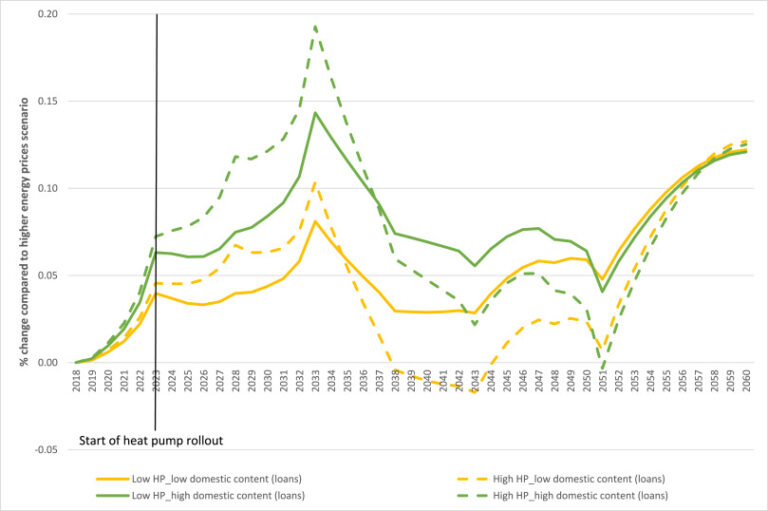Researchers simulated the rollout of heat pumps in Britain until 2050 and found that expansion strategies could help mitigate high energy prices. They used the UKENVI computable general equilibrium model (CGE) of the British economy to project a range of scenarios.
Researchers from the University of Strathclyde in the UK have analyzed how the rollout of heat pumps could ease high energy prices.
The research team used a CGE model to evaluate economic outcomes in four scenarios, each varying in heat pump costs and levels of domestic production.
“Our results show that expansive processes caused by the production and installation of heat pumps can help offset the contractionary pressure associated with higher energy prices,” the scientists said. “However, the outcomes depend on the size of the domestic supply chain content in the production of heat pumps, on the installation costs for households, on how and where government revenues arise.”
The research team used the UKENVI CGE model, based on UK data, to analyze the economic impact. They chose 2018 as the base year and forecast economic behavior through 2060, with electricity and gas prices modeled on the highest estimates in the UK Treasury Green Book.
The scientists considered several scenarios. The central scenario ran in the simulation and assumed that the average cost of purchasing and installing a heat pump starts at GBP 7,531 ($9,621), with 54% of the total expenditure going into the UK economy (25% of heat pumps, 50% of the peripheral equipment, and 100% of the installation costs). The second scenario assumed a total price of GBP 11,810, of which 58% would be spent in the UK (25%, 50% and 100% respectively).
In the third scenario, GBP 11,810 was also the starting price, but with 83% spent on the local market (75% of the heat pumps, 70% of the peripherals and 100% of the installation costs). The final scenario assumed a total amount of GBP 7,531, with 81% spent in the UK (75%, 75% and 100% respectively).
In all four cases, the researchers assumed that the cost of heat pumps would be covered directly by British households through interest-free loans that allow them to spread the cost over ten years. The rollout was expected to be completed by 2050, with a total of 10.23 million heat pumps installed.
“We can see from the results that the high volume of domestic content and the relatively higher value of production and installation activities enable the best results for the entire economy in certain time frames, including the period of high energy prices (until 2030),” said the researcher. said academics. “A high domestic content, even with persistently high installation costs, could alleviate the negative gross domestic product (GDP) pressure from higher energy prices by 0.077% in 2024 (instead of 0.037% in our central case) and the mitigation increases to 0.12% by the end of the high price period in 2030.”
The academics concluded that an “important parameter determining the extent to which the heat pump rollout will mitigate the negative effects of higher energy prices is the evolution of heat pump installation costs.” They added that “maximizing the economy-wide gains associated with heat pump rollout will ultimately require establishing a strong domestic supply chain.”
They presented their findings in “The importance of cost reduction for heat pumps and the development of the domestic supply chain in the face of persistent energy price shocks”, which was recently published in Energy strategy reviews.
This content is copyrighted and may not be reused. If you would like to collaborate with us and reuse some of our content, please contact: editors@pv-magazine.com.


